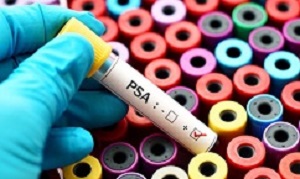A new and simple blood test that detects circulating tumour cells, used in combination with the current prostate specific antigen test (PSA), non-invasively predicted the presence of aggressive prostate cancer in subsequent biopsies with over 90% accuracy.
It has been found to efficiently and accurately detect the presence of aggressive prostate cancer, according to research by Queen Mary University of London. In combination with the current prostate specific antigen (PSA) test, the new test could help men avoid unnecessary and invasive biopsies, over-diagnosis and over-treatment.
Prostate cancer is the most common cancer in Western men, with 1.3m new cases being diagnosed each year worldwide. It is currently detected using a blood test that measures PSA levels. Although it provides early diagnosis, the PSA blood test has a low specificity (high false positives) with about 75% of all PSA positive results ending up with negative biopsies that do not find cancer.
When a high PSA level in the blood is detected, the patient undergoes a tissue biopsy of the prostate gland, which is invasive and carries a significant risk of bleeding and infection. On biopsy, the majority of patients with elevated PSA levels are found not to have cancer.
Additionally, most diagnosed early-stage prostate cancers are not fatal if left untreated. The current practice of the combined PSA test and biopsy for prostate cancer therefore results in unnecessary biopsies and over-diagnosis and overtreatment of many men.
The new prostate cancer test (the Parsortix system from ANGLE) detects early cancer cells, or circulating tumour cells (CTCs), that have left the original tumour and entered the bloodstream prior to spreading around the body. By measuring intact living cancer cells in the patient's blood, rather than the PSA protein which may be present in the blood for reasons other than cancer, it potentially provides a more accurate test for prostate cancer.
The study looked at the use of the CTC test in 98 pre-biopsy patients and 155 newly diagnosed prostate cancer patients enrolled at St Bartholomew's Hospital in London. The research team found that the presence of CTCs in pre-biopsy blood samples were indicative of the presence of aggressive prostate cancer, and efficiently and non-invasively predicted the later outcome of biopsy results.
When the CTC tests were used in combination with the current PSA test, it was able to predict the presence of aggressive prostate cancer in subsequent biopsies with over 90% accuracy, better than any previously reported biomarkers.
Additionally, the number and type of CTCs present in the blood was also indicative of the aggressiveness of the cancer. Focusing on more aggressive prostate cancer may reduce over-treatment and unnecessary biopsies for benign and non-aggressive conditions.
Lead researcher Professor Yong-Jie Lu from Queen Mary University of London said: "The current prostate cancer test often leads to unnecessary invasive biopsies and over-diagnosis and overtreatment of many men, causing significant harm to patients and a waste of valuable healthcare resources. There is clearly a need for better selection of patients to undergo the biopsy procedure.
"Testing for circulating tumour cells is efficient, non-invasive and potentially accurate, and we've now demonstrated its potential to improve the current standard of care. By combining the new CTC analysis with the current PSA test, we were able to detect prostate cancer with the highest level of accuracy ever seen in any biomarker test, which could spare many patients unnecessary biopsies. This could lead to a paradigm shift in the way we diagnose prostate cancer."
As this is a single centre study, the results need to be further validated in other independent research centres before the CTC test is available either privately or on the NHS in the UK, which could take a further 3-5 years. Clearance by the US Food and Drug Administration could also take 3-5 years.
This work was funded by Orchid Cancer Appeal, Cancer Research UK and ANGLE plc (which manufactures the Parsortix system). The funding sources had no role in the design of the study; the collection, analysis, or interpretation of the data; or the writing of the research paper.
Abstract
Purpose: PSA testing results in unnecessary biopsy and over-diagnosis with consequent over-treatment. Tissue biopsy is an invasive procedure, associated with significant morbidity. More accurate non- or minimum-invasive diagnostic approaches should be developed to avoid unnecessary prostate biopsy and over-diagnosis. We investigated the potential of using circulating tumor cell analysis in cancer diagnosis, particularly in predicting clinically significant prostate cancer in pre-biopsy patients.
Material and Methods: We enrolled 155 treatment naïve prostate cancer patients and 98 pre-biopsy patients for circulating tumor cell numeration. RNA was extracted from circulating tumor cells from 184 patients for gene expression analysis. Kruskal-Wallis, Spearman's rank, multivariate logistic regression and random forest were applied to assess the association of circulating tumor cells with aggressive prostate cancer.
Results: In localized prostate cancer patients, 54% were scored as circulating tumor cell positive, which was associated with higher Gleason score ( p=0.0003), risk group ( p<0.0001) and clinically significant prostate cancer ( p<0.0001). In pre-biopsy group, positive circulating tumor cell score in combination with PSA predicted clinically significant prostate cancer with AUC=0.869. A 12-gene panel prognostic for clinically significant prostate cancer was also identified. Combining PSA level, circulating tumor cell-score and the 12-gene panel, AUC for clinically significant prostate cancer prediction was 0.927 and in cases with multi-parametric MRI data, adding these to multi-parametric MRI significantly increased the prediction accuracy (AUC 0.936 vs 0.629).
Conclusions: Circulating tumor cell analysis has the potential to significantly improve patient stratification by PSA and/or multi-parametric MRI for biopsy and treatment.
Authors
Lei Xu, Xueying Mao, Alistair Grey, Glenda Scandura, Tianyu Guo, Edwina Burke, Jacek Marzec, Semah Abdu, Elzbieta Stankiewicz, Caitlin R Davies, Prabhakar Rajan, Karen Tipples, John Hines, Pui Ying Chan, Diane Campbell, Karen Wilkinson, Sakunthala Kudahetti, Jonathan Shamash, Tim Oliver, Daniel Berney, Greg Shaw, Yong-Jie Lu
[link url="https://www.qmul.ac.uk/media/news/2019/smd/new-blood-test-for-prostate-cancer-is-highly-accurate-and-avoids-invasive-biopsies.html"]Queen Mary University of London material[/link]
[link url="https://www.auajournals.org/doi/10.1097/JU.0000000000000475"]Journal of Urology abstract[/link]

